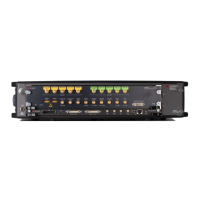<sequence_id> 0…512K-2
<step> sequence table entry in the sequence. Valid range is 0 to <length>-1 defined
with seq:def:new
<length> number of sequence steps to be read
The command form writes one or multiple sequence steps beginning at <step>. Each
step consists of 6 32-bit words per entry with the following meanings.
<segment_id>id of the segment.
<loop_count> number of segment loop iterations 1…4G-1
<advance_mode> 0: AUTO, 1: CONDitional, 2: REPeat, 3: SINGle. Specifies how the
generator advances from one sequence table entry to the next one.
<marker_enable> 0: Marker disabled, 1: Marker enabled
<start_addr> Address of the first sample within the segment to be inserted into the
sequence.
<end_addr> Address of the last sample in the segment to be inserted into the
sequence. You can use 0xffffffff to specify the last sample of the segment.
Individual entries, multiple entries or even the complete sequence at once can be
written. The data can be given in IEEE binary block format or as a comma-separated
list of 32-bit values.
The query form returns for a given sequence-id and step the segment data items
(segment-id, loop-count, advance-mode, marker-enable, start-addr, end-addr).
If the sequence does not exist or the step is greater than the sequence length – 1, an
error is generated.
Command
:SEQ1:DATA 0,0,1,1,1,0,0,239
Command using data block
[:SOURce]:SEQuence[1|2]:DATA <sequence_id>,<step>, <data_block>
:SEQ1:DATA 0,0,<data_block>
Query
:SEQ:DATA? 0,1,1

